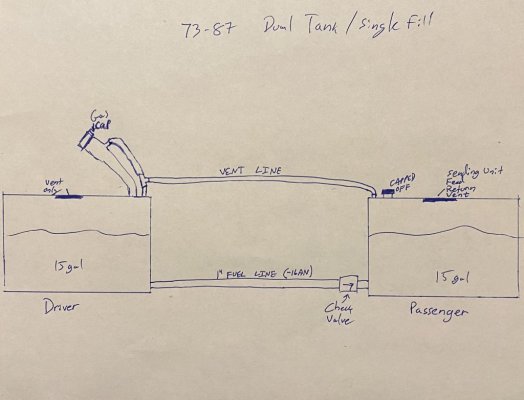Phil 83K20
Full Access Member
- Joined
- Jul 27, 2021
- Posts
- 144
- Reaction score
- 216
- Location
- CT
- First Name
- Philip
- Truck Year
- 1983
- Truck Model
- K20
- Engine Size
- 350
I know this has been discussed previously, but I couldn’t find the thread.
The idea of having 2 tanks that are both feeding the motor, to eliminate the need for a tank switch, has been knocking around my melon for quite some time and I think I came up with a solution.
I drew a quick diagram, so skip to that if you don’t want to read out it…
Basically, I’m proposing filling from the drivers side, connecting the two with a pair of hoses, and feeding the beast from the passenger side. The addition of a check valve between the two tanks makes it so that the driver tank can flow into the passenger, but not the other way around.
It’d use a single sending unit, feed, and return setup; I personally don’t need a precise readout of the remaining fuel in the secondary tank.
Look it over and let me know if you find any problems that I overlooked.
The idea of having 2 tanks that are both feeding the motor, to eliminate the need for a tank switch, has been knocking around my melon for quite some time and I think I came up with a solution.
I drew a quick diagram, so skip to that if you don’t want to read out it…
Basically, I’m proposing filling from the drivers side, connecting the two with a pair of hoses, and feeding the beast from the passenger side. The addition of a check valve between the two tanks makes it so that the driver tank can flow into the passenger, but not the other way around.
It’d use a single sending unit, feed, and return setup; I personally don’t need a precise readout of the remaining fuel in the secondary tank.
Look it over and let me know if you find any problems that I overlooked.




